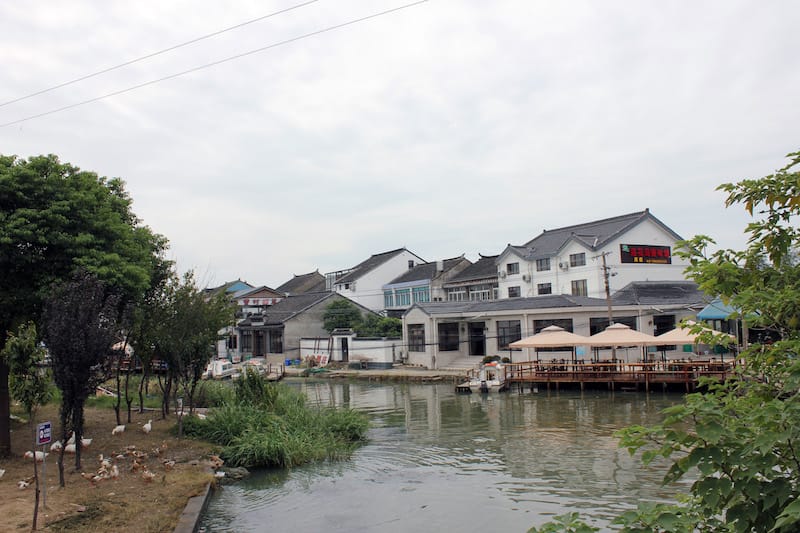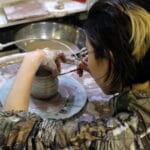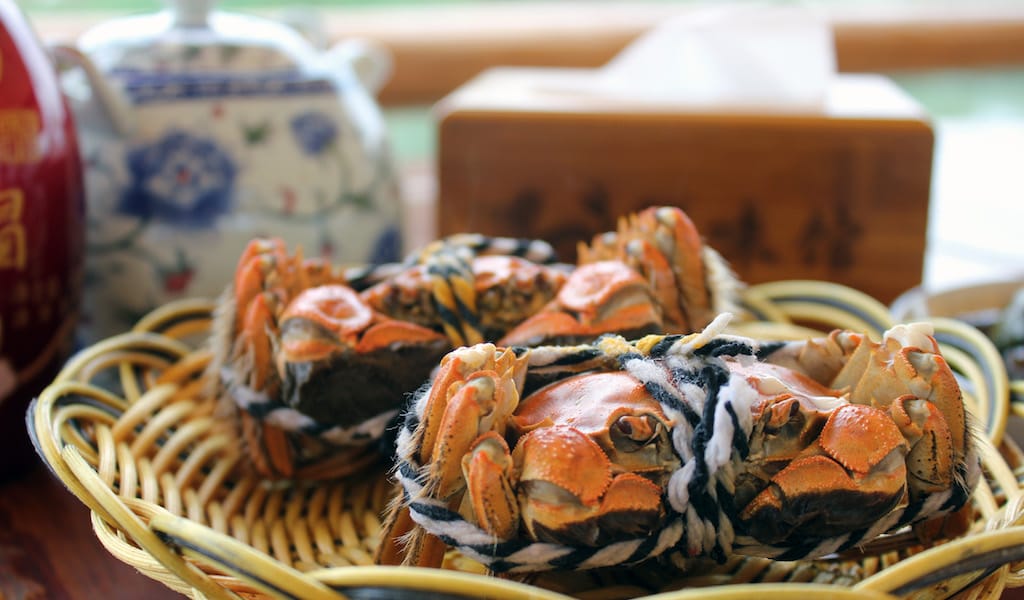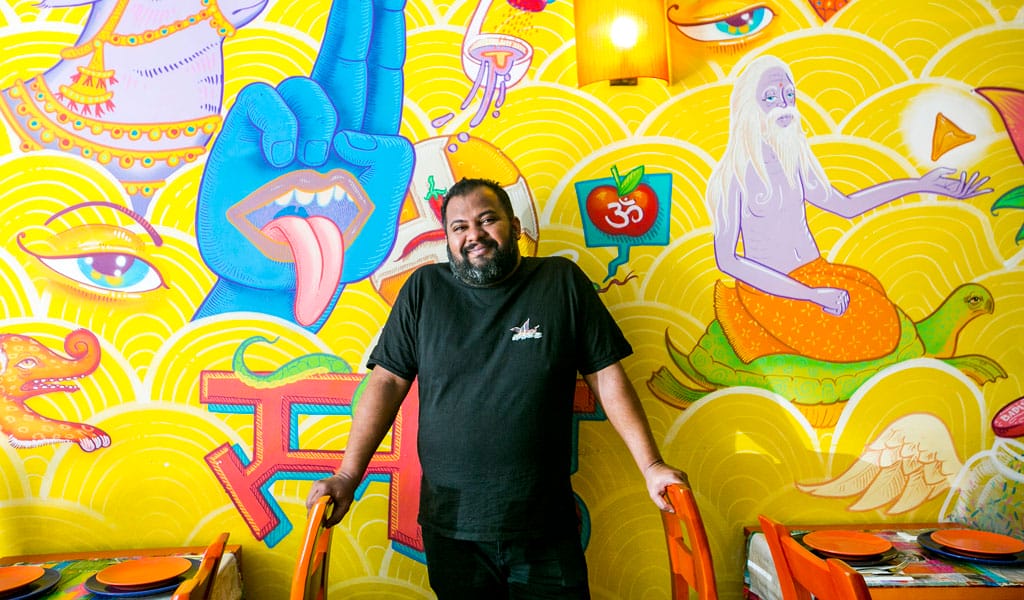In the sections of China’s Jiangsu Province where Huaiyang cuisine reigns supreme, autumn is marked not by yellow and red foliage or falling temperatures. The change in seasons instead comes when restaurants post hairy crab (大闸蟹 Dàzháxiè) menus and shops selling baked goods the rest of the year pivot to aquariums full of the live crabs – named for their furry claws, these medium-sized burrowing crabs, also called Chinese mitten crabs, can be seen trying to scale the glass walls.
Peak hairy crab season falls during the ninth and tenth lunar month of the year. In 2017, that means from October 20 until December 17. But when we arrived at Yangcheng Lake – a hairy crab mecca – before China’s National Holiday on October 1, the lake was already lined with hawkers wrapping the live crabs with twine and selling them to hungry tourists.

On the northern shore of Yangcheng Lake is Lianhuadao (Lotus Island) – a partial misnomer, as the so-called island is actually a peninsula. Sections of Lotus Island measure less than 200 meters wide, but in whole it covers 3.2 kilometers as it stretches, like a long spindly finger, into the lake’s center, surrounded on three sides by the placemat-sized leaves of the lotus flower.
Lotus Island is a perfect jumping-off point for crab farmers (all the crustaceans in this lake are now raised not caught). As a result, the peninsula is home to a few fishing villages; the 300 or so families that live in these villages have doubled their industry in recent years by opening their homes to tourists as nong jia le (“Happy Farmer Homes”), a Chinese take on Italy’s agriturismo, but with a lot less regulation and a lot more variation in quality.
Rural tourism has taken off around China in recent decades, starting in the late 1980s as urban dwellers grew richer in the new open economy. Nong jia le became a tourism model to spread the wealth around and offer residents of China’s megacities a chance to get back in touch with the land, sometimes literally with farm work.
The residents seem to understand that tourists are here to eat hairy crab.
On Lotus Island, the infrastructure for tourists to spend days exploring the ecologically-protected zone just isn’t in place. This year they rebuilt a Pharmacist’s Temple complete with an eight-meter tall golden Pharmacist Buddha to replace one the government destroyed years ago, but other sights like “Windmill Array” and “Ox Fetching Water” are rundown wooden structures leaning windward behind decrepit boats filled with algae. The residents seem to understand that tourists are here to eat the crabs, and that’s what you should do too – perhaps in conjunction with a trip to Suzhou’s famed gardens or the Suzhou Museum, designed by I.M. Pei.
And a lunch trip is easy to do – walk into any of the villages (transport from the docks and the mainland are available via electric trolleys) and a friendly local will immediately ask you if you’ve eaten. If you haven’t, they’ll invite you to check out the aquariums at their guesthouse, where you can select your crabs. During the ninth lunar month, ask for the round-bellied female crabs. During the tenth month, ask for male crabs, identifiable by the triangle flap on their belly.

After ordering a couple of homestyle sides a la carte, you’ll be escorted to the “dining room,” often a covered floating boat in the canal that runs through town or alongside the shore. It’s no-frills dining at its finest. And if you prefer to cook them yourself, there are vendors along the canal who tie them up for transport home.
When hairy crab season ends on Lotus Island, there’s always rapeseed blooming to look forward to. Come spring, the peninsula is covered in the bright yellow flowers. Since rapeseed farms take up 70 percent of the Lotus Island’s land and are a major source of local pride, don’t be surprised to see a Chinglish sign or two extolling the virtues of the rape flower.
Getting there: From Shanghai, take a high-speed train to Suzhou North train station (about 25 minutes), then take a taxi to Lotus Island’s North Pier (莲花岛被码头). From there you can get a slow boat across to the peninsula’s tip (RMB 15) or an electric trolley through the fields (RMB 10).
Where to Eat Hairy Crab in Shanghai:
UnTour Food Tours’ Hairy Crab Feast
UnTour Food Tours launched a seasonal Hairy Crab Feast food tour that samples crab roe xiaolongbao, lion’s head meatballs crowned with crab, and whole crabs – along with instructions on how to crack into them properly – plus so much more. Dates are October 28 and November 11, 25 and 26 for US$80.
A Niang Mian
This Ningbo-style noodle house serves yellow croaker noodles most of the year, but come autumn, it’s all about the hairy crab noodles. Served in the croakers’ velvety broth, the wheat noodles are topped with hairy crab roe and meat. Try not to come at peak meal time, or you’ll be hovering for a seat.
Kong Yi Ji
Located around the corner from the Confucius Temple, this restaurant in Old Town has an old Shanghai vibe, and the menu offers over a dozen hairy crab dishes when it’s in season. The focus year-round is squarely on Shaoxing wine (huangjiu), which pairs perfectly with hairy crab.
Editor’s Note: Autumn has officially arrived, and with it comes a new updated batch of Fall-Winter Eatineraries, CB’s seasonal self-guided food itineraries for travelers. The 2017-2018 Shanghai Eatinerary has the inside scoop on where to go for everything from the hairiest hairy crab to the tastiest tāngyuán (winter dumplings) in town.
 May 11, 2022 Oumalala
May 11, 2022 Oumalala
A month ago, I moved into to my new place in Marseille’s La Plaine neighborhood. After […] Posted in Marseille May 2, 2017 Jesus é Goês
May 2, 2017 Jesus é Goês
Order a plate of vindalho in one of the many Goan restaurants around Lisbon and your […] Posted in Lisbon August 15, 2022 CB on the Road: A Tale of Two Ceramicists
August 15, 2022 CB on the Road: A Tale of Two Ceramicists
Amanda Tong’s hands are grey with liquid porcelain as she slowly shapes a small pitcher […] Posted in Tokyo
Published on October 11, 2017
Related stories
May 11, 2022
Marseille | By Jenine Abboushi
MarseilleA month ago, I moved into to my new place in Marseille’s La Plaine neighborhood. After the moving truck drove off, leaving me with stacks of boxes and furniture and no food yet in the refrigerator, I ventured out in my dusty jeans to find a place to eat some lunch in the neighborhood. On…
May 2, 2017
LisbonOrder a plate of vindalho in one of the many Goan restaurants around Lisbon and your local friend at the table may point out that the origin of this dish is, in fact, Portuguese. Even the name can be decoded back to the Portuguese vinha d’alhos (wine and garlic), he’ll say. But let’s be honest here,…
August 15, 2022
Tokyo | By Florentyna Leow
TokyoAmanda Tong’s hands are grey with liquid porcelain as she slowly shapes a small pitcher on her potter’s wheel. Marbled clay rises and flattens under her strong hands, larger than you’d expect from her slight stature. Behind her, Jun Matsumura scrapes tendrils of clay off a partially-dried vessel, sharpening its elegant curves. Cantonese pop music…


















































































